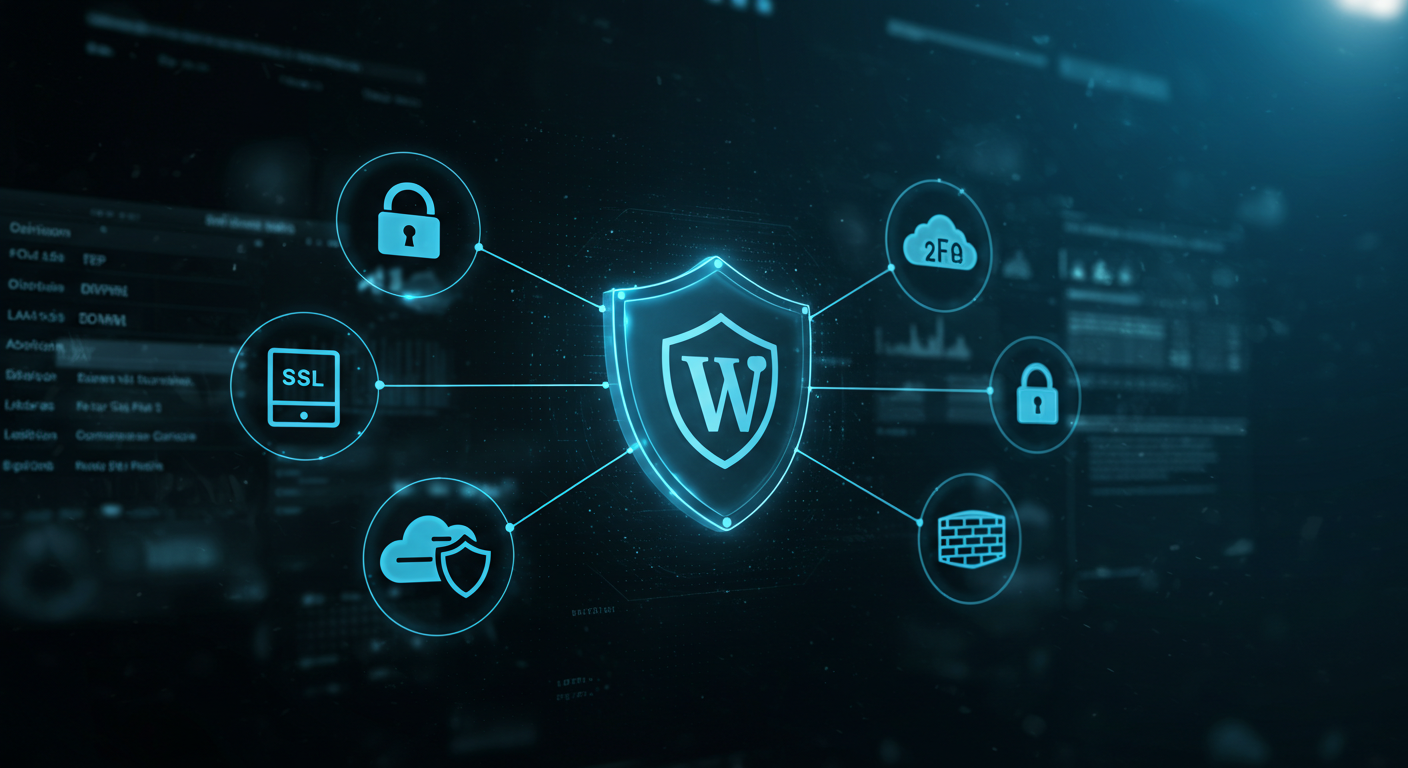
WordPress Hardening on cPanel/WHM: Complete Security Guide
WordPress Hardening on cPanel/WHM: Complete Security Guide
Introduction: The Security Imperative for WordPress Sites
WordPress powers over 43% of all websites globally, making it a prime target for cybercriminals, hackers, and automated attacks. If you’re running WordPress on cPanel/WHM infrastructure, implementing comprehensive security hardening isn’t optional—it’s essential for protecting your data, maintaining customer trust, and ensuring business continuity.
This guide walks you through critical security measures, including Web Application Firewall configuration, ModSecurity rules optimization, two-factor authentication implementation, robust backup strategies, and zero-downtime SSL management. Each element works together to create multiple layers of defense, ensuring your WordPress sites remain secure, available, and performant.
Web Application Firewall (WAF) Configuration
A properly configured Web Application Firewall serves as your first line of defense against common attacks, including SQL injection, cross-site scripting (XSS), and malicious bot traffic. Within cPanel/WHM, ModSecurity provides enterprise-grade WAF capabilities that can block threats before they reach your WordPress installation.
Start by enabling ModSecurity in WHM’s Security Center. The default ruleset provides baseline protection, but WordPress-specific tuning is essential. Install the OWASP ModSecurity Core Rule Set (CRS), which includes comprehensive protections against the OWASP Top 10 vulnerabilities. These rules specifically recognize WordPress attack patterns and can prevent common exploits targeting wp-admin, wp-login.php, and plugin vulnerabilities.
Configure ModSecurity to run in blocking mode rather than detection-only mode. While detection mode helps you identify false positives during initial setup, blocking mode actively prevents attacks. Monitor your ModSecurity logs regularly through WHM’s interface to identify legitimate requests being blocked, then create custom whitelist rules for your specific WordPress setup.
ALSO, READ Entity SEO & Topical Authority: 90-Day Plan
Implement rate-limiting rules to prevent brute-force attacks against wp-login.php. Configure ModSecurity to temporarily block IP addresses that attempt more than five failed login attempts within two minutes. This simple rule eliminates the vast majority of automated login attacks without impacting legitimate users.
Consider using Cloudflare or Sucuri as an additional external WAF layer. These services provide DDoS protection, global CDN capabilities, and constantly updated threat intelligence that complements your server-level ModSecurity configuration. The combination of edge-level and server-level protection creates a robust defense-in-depth security architecture.
Two-Factor Authentication (2FA) Implementation
Username and password combinations alone are insufficient protection in today’s threat landscape. Two-factor authentication adds a critical second verification layer that protects accounts even when passwords are compromised through phishing, data breaches, or brute force attacks.
For cPanel/WHM access, enable two-factor authentication in WHM’s Tweak Settings under Security. This requires administrators to provide both their password and a time-based one-time password (TOTP) generated by apps like Google Authenticator or Authy. Configure this immediately for all WHM root and reseller accounts—these high-privilege accounts are prime targets for attackers.
ALSO, READ Core Web Vitals Playbook: How to Hit 90+ on Mobile
Within WordPress, implement 2FA using plugins like Wordfence, WP 2FA, or Two Factor Authentication. Choose plugins that support multiple 2FA methods, including authenticator apps, SMS backup codes, and email verification. Configure 2FA requirements for all administrator and editor accounts at a minimum, as these roles have sufficient privileges to compromise your entire site.
Create clear documentation for your team on 2FA setup and recovery procedures. Store backup codes securely in a password manager or encrypted document. Establish procedures for account recovery when users lose access to their 2FA devices, balancing security with usability to prevent legitimate users from being locked out permanently.
Test your 2FA implementation thoroughly across different devices and scenarios. Ensure the authentication flow works correctly on mobile devices, that backup methods function when primary methods fail, and that the user experience remains reasonable while maintaining strong security. Poor implementation can frustrate users and lead to security bypasses.
Comprehensive Backup Strategies
Backups serve dual purposes: recovery from security incidents and protection against data loss from hardware failures, human error, or site corruption. A robust backup strategy ensures you can restore your WordPress site to a known-good state within minutes, minimizing downtime and data loss.
Configure automated backups through cPanel’s backup interface or WHM’s backup configuration. Set daily incremental backups for files and databases, with full backups weekly. Store backups both on the server and remotely—storing backups only on the same server does not protect against server failures, ransomware, or catastrophic events.
Implement the 3-2-1 backup rule: maintain three copies of your data, on two different media types, with one copy stored offsite. Use cPanel’s backup transport options to automatically send backups to remote destinations like Amazon S3, Google Drive, or dedicated backup servers. This geographic and infrastructure diversity ensures data survival through virtually any disaster scenario.
Test your backup restoration process regularly—monthly at minimum. Many organizations discover their backups are corrupted or incomplete only when attempting emergency restoration. Schedule test restorations to staging environments, documenting the time required and any issues encountered. This practice ensures your backups work when you need them most and provides realistic recovery time estimates.
ALSO, READ The 7-Block Homepage That Converts (With Wireframes)
Use WordPress-specific backup plugins like UpdraftPlus, BackupBuddy, or BlogVault for application-level backups that understand WordPress structure. These tools can back up your database, media files, themes, and plugins separately, enabling granular restoration. They also handle WordPress-specific considerations like database table prefixes and multisite configurations that generic backup tools might miss.
Zero-Downtime SSL Management
SSL certificates are no longer optional—they’re required for security, SEO, and user trust. Modern SSL management must be automated, reliable, and implemented without service interruptions that impact users or search engine crawlers.
Let’s Encrypt integration in cPanel provides free, automatically-renewing SSL certificates that eliminate both cost and management overhead. Enable AutoSSL in WHM to automatically provision and renew certificates for all domains on your server. AutoSSL checks for expiring certificates daily and renews them 30 days before expiration, ensuring certificates never expire unexpectedly.
Configure HTTPS redirection at the server level using .htaccess rules or cPanel’s redirect interface. This ensures all traffic uses encrypted connections without requiring WordPress plugins. Server-level redirects are faster and more reliable than plugin-based redirects, and they protect wp-admin access before WordPress even loads.
Implement HSTS (HTTP Strict Transport Security) headers to instruct browsers to always use HTTPS for your domain. Add the header through cPanel’s Apache configuration or WordPress: Strict-Transport-Security: max-age=31536000; includeSubDomains; preload. This prevents downgrade attacks and ensures browsers never attempt unencrypted connections to your site.
ALSO, READ Design Systems for WordPress: Tokens + Tailwind + Gutenberg
Monitor certificate expiration dates even with automation enabled. Set up monitoring through services like SSL Labs or UptimeRobot that alert you when certificates are approaching expiration or have configuration issues. While AutoSSL is reliable, monitoring provides an additional safety net ensuring you’re notified of any automation failures before they impact your site.
Additional Security Hardening Measures
Beyond the core security measures, implement these additional hardening techniques for comprehensive WordPress protection on cPanel/WHM.
Disable XML-RPC if you don’t need it for remote publishing or mobile apps. XML-RPC is frequently targeted for brute force attacks and DDoS amplification. Block access through .htaccess rules or disable the functionality entirely through WordPress security plugins.
Change your WordPress database table prefix from the default “wp_” to something unique. This simple change prevents automated SQL injection attacks that assume standard table naming conventions. Make this change during initial installation or carefully using database rename tools—incorrect implementation can break your site.
Limit PHP execution to specific directories, preventing uploaded files from executing malicious code. Configure cPanel to disable PHP execution in the wp-content/uploads directory through .htaccess rules: php_flag engine off. This prevents attackers from uploading PHP shells disguised as images.
Keep WordPress core, themes, and plugins updated religiously. Enable automatic updates for minor WordPress releases and security patches. Review and test major updates in staging environments before applying to production, but prioritize security updates—delayed security patches are the leading cause of WordPress compromises.
Conclusion: Maintaining Ongoing Security
WordPress security isn’t a one-time configuration—it requires ongoing vigilance, regular updates, and continuous monitoring. The hardening measures outlined in this guide provide robust protection when implemented comprehensively and maintained consistently.
Schedule regular security audits quarterly to review your configuration, update rules, and identify new vulnerabilities. Stay informed about WordPress security trends through resources like WPScan Vulnerability Database and WordPress security mailing lists. Subscribe to security notifications from your hosting provider and plugin developers.
Document your security configuration thoroughly, including custom ModSecurity rules, backup procedures, and recovery processes. This documentation ensures your team can maintain security standards and respond effectively to incidents. Treat security as an ongoing investment in your business continuity and customer trust.
The combination of WAF protection, two-factor authentication, comprehensive backups, and proper SSL management creates a defense-in-depth security posture that can withstand most attacks. While no security is absolute, these measures make your WordPress site a harder target, encouraging attackers to move to easier victims while protecting your data, reputation, and business.
FAQ
1. What’s the difference between ModSecurity and a WordPress security plugin?
ModSecurity operates at the server level in cPanel/WHM, filtering malicious requests before they reach WordPress, while security plugins work within WordPress after requests arrive. ModSecurity provides broader protection, including non-WordPress attacks, consumes fewer resources, and can’t be bypassed by compromising WordPress, making it a crucial first layer of defense that complements rather than replaces WordPress security plugins.
2. How often should I back up my WordPress site on cPanel?
Backup your WordPress site daily with incremental backups and weekly full backups stored both locally and remotely, following the 3-2-1 rule. High-traffic sites or e-commerce stores should consider hourly database backups to minimize data loss. Always maintain at least 30 days of backup history and test restoration monthly to ensure backups work when needed.
3. Will enabling ModSecurity WAF slow down my WordPress site?
ModSecurity typically adds only 1-5 milliseconds of processing time per request—imperceptible to users—while the security benefits far outweigh minimal performance impact. Properly configured ModSecurity rules can actually improve performance by blocking malicious traffic and bot attacks before they consume server resources. Start with detection mode, optimize rules to eliminate false positives, then switch to blocking mode for optimal security without performance degradation.
4. Can I use free Let’s Encrypt SSL certificates for commercial WordPress sites?
Yes, Let’s Encrypt SSL certificates provide the same encryption strength as paid certificates and are fully suitable for commercial WordPress sites, e-commerce stores, and business websites. The main differences from paid certificates are the 90-day validity period (automatically renewed by cPanel AutoSSL), lack of warranty coverage, and absence of extended validation (EV) features that display company names in browser address bars—features most businesses don’t require.
5. What should I do if ModSecurity blocks legitimate WordPress functionality?
Review ModSecurity audit logs in WHM to identify the specific rule triggering false positives, then create custom whitelist rules for your WordPress installation. Common causes include contact form submissions, theme/plugin updates, and complex page builders triggering XSS rules. Add rule exceptions for specific URLs or parameters rather than disabling rules globally, maintaining security while allowing legitimate functionality. Most WordPress security plugins provide pre-configured ModSecurity whitelist rules for common false positives.
How do I secure WordPress on cPanel?
Secure WordPress on cPanel by enabling ModSecurity WAF with OWASP rules, implementing two-factor authentication for all admin accounts, configuring automated daily backups with off-site storage, enabling AutoSSL for automatic certificate renewal, and disabling XML-RPC to prevent brute force attacks.




